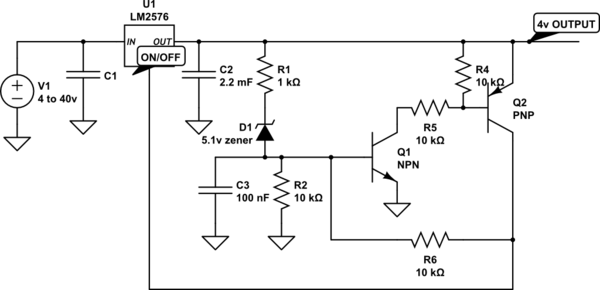I'm trying to shut down an LM2576 regulator in the event that one of its adjusting resistors fails open. I'd like to use the ON/OFF pin on the regulator as this seemed as though it should be easy and cheap, and stops the current rather than having it dissipated as heat. The input is between 5 and 37v, and if this resistor fails, it sends that voltage all the way through to the rest of my circuit, exploding capacitors and killing the processor.
The ON/Off pin needs 1.4v to start shutting down the regulator, which i'm able to feed from the 5.1v zener as in the schematic below (I hope it's below, this is my first post, sorry if i've got it wrong!) But it needs around 5v for full shutdown, which is what I'd like. The schematic is simplified obviously, there are capacitors and whatnot in there as needed by the LM2576
My problem is that by feeding it through the zener, it only limits the output to 6.7v, I assume because this is the voltage the zener needs to give the pin 1.4v. This is enough to stop things exploding, but not really to fully protect the circuit. If i give a direct 5v or 12v or whatever to the pin, it shuts it down completely. I've tried using the zener to feed a transistor, but this just ups the voltage to 7.2ish, and as the pin needs to be pulled high, i can't just use the transistor to go to GND.
I'm sure I'm missing something really obvious, but I can't see it! Can anyone help please?!

simulate this circuit – Schematic created using CircuitLab




